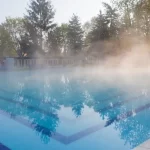
Let’s be honest. When you think of a pool, you probably picture splashing kids, floating lounge chairs, and the smell of chlorine on a hot day. But there’s another kind of pool—a quieter, more intentional space. A place where the water isn’t for play, but for profound healing and restoration.
Therapeutic pools are engineered environments designed to support physical recovery and mental well-being. They’re like a liquid support system, a partner in your journey back to strength. And the secret to their power lies in the specific features they offer. Let’s dive into the world of aquatic therapy and explore the features that make all the difference.
The Foundation: It All Starts with Temperature and Current
Before we get to the bells and whistles, two fundamental elements set the stage for any therapeutic aquatic experience.
Precise Temperature Control
This isn’t your average chilly swimming pool. For true aquatic therapy and rehabilitation, temperature is a critical tool.
- Warm Water Therapy Pools (90-94°F / 32-34°C): This is the sweet spot for most therapeutic applications. The warmth soothes aching muscles, increases blood flow, and reduces muscle spasms. It allows joints to move more freely, making exercise less painful. It’s like a warm, full-body hug that lets your body relax into movement.
- Colder Pools (below 85°F / 29°C): Used more for athletic training or vigorous aquatic fitness where overheating is a concern.
Honestly, that warm water can be a game-changer for someone with arthritis or chronic pain. It makes the impossible feel possible.
Adjustable Current Systems
Imagine a treadmill, but in water. That’s essentially what a current system, or a swim jet, creates. You can walk or swim against a controllable, consistent flow of water. This is fantastic for:
- Low-Impact Cardio: Getting your heart rate up without pounding your joints on pavement.
- Gait Training: Re-learning how to walk properly after an injury or surgery with the water’s buoyancy providing support.
- Progressive Resistance: As you get stronger, you simply increase the current speed. It’s a built-in progression system.
Key Features for Targeted Rehabilitation
Okay, so we have our warm, moving water. Now, let’s add the tools that physical therapists and patients rely on every day.
Underwater Treadmills & Floor Jets
An underwater treadmill is exactly what it sounds like—a treadmill built into the floor of the pool. It allows for a normalized walking pattern in a reduced-gravity environment. Paired with adjustable floor jets, you can create resistance at the feet and ankles to specifically target lower-body strength and stability. This is a cornerstone of post-surgical rehab, especially for knees and hips.
Variable Depth Pools (The Gradual Entry)
Steps and ladders can be a major barrier for individuals with limited mobility. A gradual, sloping entry—often called a beach entry or zero-depth entry—allows someone to walk into the water slowly and confidently. They can stop at whatever depth is comfortable for them. It provides a sense of control and safety that is absolutely vital.
Accessibility & Support Features
This is where thoughtful design truly shines. Things like:
- Wide Pool Ledges: To sit on the edge and ease into the water.
- Overhead Lift Systems: For individuals who cannot use steps, a ceiling-mounted lift provides safe, dignified access.
- Ample Handrails & Grab Bars: Strategically placed both in and out of the water for constant support.
Designing for Serenity: The Wellness Angle
Therapeutic pools aren’t just for physical rehab. They’re increasingly designed for mental wellness, too. It’s about creating an environment that engages the senses and calms the nervous system.
Aquatic Massage & Hydrotherapy Jets
Forget the single jet in a hot tub. We’re talking about strategically placed, powerful jets that target large muscle groups like the back, shoulders, and legs. Sitting or standing in front of one of these can provide a deep tissue massage, relieving tension and promoting relaxation in a way that’s difficult to achieve on land.
Chromotherapy (Color Light Therapy)
You might be skeptical, and that’s fair. But the use of colored lights in the water is a growing trend in wellness pool design. The idea is that different colors can influence mood. Soft blue for calmness, green for balance, a warm amber for energy. It’s a subtle feature, but it adds a powerful sensory layer to the experience.
Resistance Stations & Built-In Seating
These are the “workout corners” of the pool. They might include built-in bars for stretching, resistance bands anchored to the wall, or underwater benches. This allows for structured, independent exercise in a supported environment. You can do your physical therapy exercises without needing someone to hold you up.
Here’s a quick look at how some features serve different purposes:
| Feature | Primary Benefit | Ideal For |
| Warm Water (90-94°F) | Muscle relaxation, pain relief | Arthritis, fibromyalgia, chronic pain |
| Underwater Treadmill | Gait retraining, weight-bearing exercise | Post-surgical rehab (knee/hip), stroke recovery |
| Adjustable Current | Cardiovascular fitness, resistance training | Athletic conditioning, general strength building |
| Hydrotherapy Jets | Deep tissue massage, stress reduction | Muscle tension, mental wellness, recovery |
| Gradual Entry | Safe, accessible entry | Mobility challenges, fear of water |
Bringing It All Together: A Space for Transformation
So, what’s the real takeaway here? A therapeutic pool is more than a collection of features. It’s an ecosystem. The warm water holds you. The current challenges you. The jets soothe you. And the accessible design empowers you.
Whether the goal is to recover from a major surgery, manage the daily grind of a chronic condition, or simply find a half-hour of peace away from the noise of the world, these pools provide a unique medium for progress. They remind us that sometimes, the most solid steps forward are taken not on solid ground, but suspended in water.










